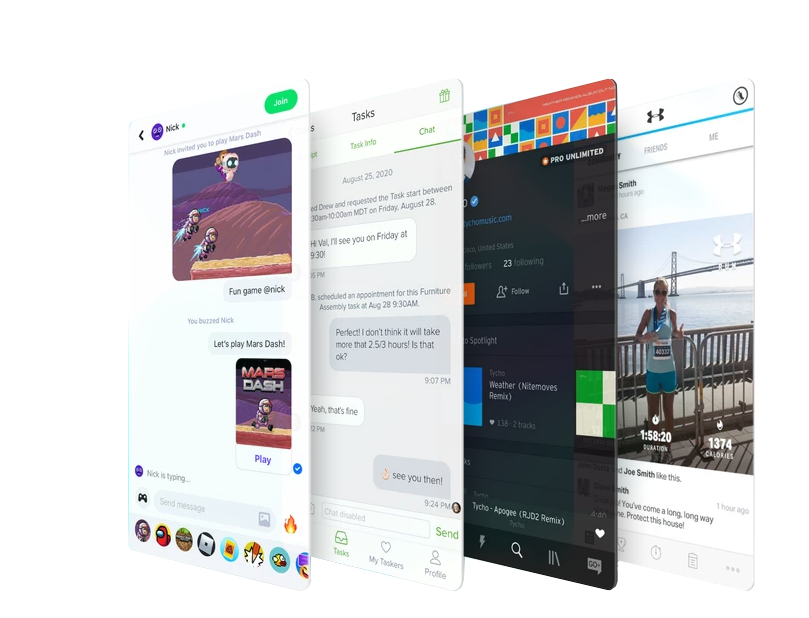As a LEAN+Agile dev house dedicated to building apps and websites for our clients, we are always advising our clients to buy functionality where they can instead of building it.
We are as aware of their runway as they are. And we’re dedicated to getting them to launch with the best MVP possible. And when speed counts and budgets are limited, and even when they’re not, we always go for buy over build.
Our clients are often surprised by not just the quality but the depth of functionality that is now available to be integrated via APIs from thousands of providers.
Here’s a list of some of the more useful and powerful integrations you should be considering. Note – this isn’t a survey. We’re not providing options or reviews. Think of it more as a proof of existence and a starting point for doing your own dive into the SaaS options out there.
Feed as a Service – stream

A news feed or activity feed with the rich interactions we’re all accustomed to – likes, tagging friends, etc – drives engagement. Feeds aren’t just for social sites. They’re for marketplaces, ecommerce, any app or website that involves events happening in realtime that someone somewhere wants to see. If you have a database its contents can probably be presented as an infinite scrolling feed to your users to like and share.
All that rich interactivity is complex and time-consuming to implement. Then there’s the technical difficulties involved in delivering the feed to all your users so they have a smooth, hiccup-free experience. You’re looking at 1000s of programmer hours whether you sit down and do it right and eat the delay, or launch with the basics working and iterate towards the complete solution.
stream provides APIs for client and server feed management as well SDKs for building apps and websites that integrate their feeds.
Authentication as a Service – Auth0

How many ways are there for potential customers to login and access your product? Email address + password? Social logins? Magic email link? SMS link? Let them use it anonymously and authenticate later? Multi-factor authentication using a code sent via SMS, voice, a one-time password app, a hardware key or biometrics?
It depends, doesn’t it. But security is one of the hardest things to get right. A home-rolled solution will be enough for the early stages of development, but once you’re live on the internet your vulnerability is related to how much money, time and expertise you can spend on security.
Or you can use a provider such as Auth0 who is solely focused on secure authentication.
Fraud Detection as a Service – Sift Science
As the pandemic created a surge in internet usage and online purchases, it also created a surge in digital fraud across both true fraud and friendly fraud categories. If you haven’t heard of friendly fraud, it mainly manifests as chargeback fraud – customers claiming they never received their order.
Digital fraud requires cooperation and huge datasets to detect and defeat. It’s not something you can do on your own. Services like Stripe Payments and Sift Science integrate thousands of data feeds and signals – such as device fingerprints, transaction histories – to predict and mitigate fraud.
Should you be using their services? If you’re not sure, your accountant can probably tell you.
Images as a service – imgix
Images have a huge impact on your users’ perception of your app or site. They can make it look more engaging, but due to their size loading them can also slow it down. If you rely on user-generated content, like a restaurant recommendation app would, or a marketplace, or you have your own deep catalogue of product images, then handling images and handling them well is an absolute necessity.
But manipulating images is technically challenging and delivering them quickly to your users takes planning and infrastructure.
Services like imgix save you from having to develop inhouse image editing and management expertise. It provides an API that can crop, resize and compress images, and a CDN for caching and delivering them to your users.
You might say there are open source libraries for manipulating images and Amazon has a CDN, so why? You can ask the same question for every service in this article. The answer is time. Time now, as you move towards launch as quickly as you can, and time later, when you lose feature development hours to maintaining and debugging the code you wrote in house.
Recommendations as a service – Algolia
You have an online store. It would be nice to increase Average Order Value by surfacing appropriate products for your customers. Where do you even start on that? Do your developers need to know statistics? Machine learning? Can you afford developers that already have the skills?
Even with a feature that will deliver a positive ROI it may end up being too expensive, again in time as well as money, to implement or just impossible. A lot of the modern user experience is pretty close to rocket science. But not everyone can hire rocket scientists.
But a service like Algolia lets you access that rocket science through an API that is easily integrated and with pricing that is easy to sign off on.
User Comms as a Service – twilio
There are dozens of services that will help you put a chatbox on your site or in your app. Making it easy for a customer to talk to a rep to help boost conversions is a strategy that is growing in popularity as it gets easier to implement.
A text chat today might lead later to a call to support after purchase or an email with warranty information or a newsletter with your latest offers.
We’re highlighting twilio for this category because their service offers APIs that allow you to integrate chat, voice and email comms with your customers. On top of the comms, it allows you to unify all your interactions with each customer to streamline engagement and allow you to personalise their interactions with your business.
This is the kind of feature you don’t even dream of being able to build for yourself. You use theirs and you’re grateful you can leverage it to your advantage.
Payments as a Service
This is a no-brainer. There is no question you are going to use a third party payments API. You’re trying to launch here, not reinvent online banking. The question you have to answer is which one, or which ones, are you going to integrate?
And are you going to stick to straight payments through a service like Stripe or are you going to integrate a Buy Now Pay Later service like Afterpay or Klarna?
Onboarding as a Service – Pendo
For an app or site of any complexity one of the biggest challenges is onboarding new users so they can use your powerful features, recognise the value of your product, and become long term customers.
This onboarding is handled by tours using on-screen pop-ups and overlays. The value is in the tour, not in the code that animates the tour.
The advantage of integrating a service like Pendo is that their implementation of product tours has advanced to the point where it offers authoring tools. This frees your developers from having to dedicate time to what is intrinsically a marketing function.
Pendo also collects data so you can see which features are being used, allowing you to continuously improve your onboarding experience and profit from it.
Shipping as a Service – ShipEngine

If your business deals in physical items then you’re going to be dealing with the headaches of shipping. It’s a time sink that cuts into the profits of every transaction.
Services like ShipEngine let you use a single integration to hook into a network of delivery and logistics companies, allowing you to optimise your costs and helping quickly and painlessly arrange local, national or international deliveries.
Security as a Service – Wazuh
Your business is online. You have a server. Perhaps multiple servers. They’re all connected to that hive of scum and villainy that is the modern internet. What are you doing to keep your business secure? How much time and how many developers and devops can you dedicate to security?
Staying current with threats and mitigations is a full-time job for a team. Being able to lean on the smarts of a large, dedicated security team through services like Wazuh reduces the risk of you being knocked offline or worse.
Are you going to buy or build?
Software is a different kind of business. And if you have a website or an app make no mistake, you are in the software business. Pick almost any portion of an app or service and a deep expertise is either necessary or provides a huge advantage.
This is what makes SaaS such a pervasive model. It’s the expense of expertise distributed across hundreds of customers. This business model is creating the re-usable modularity of functionality that software businesses have been wishing for since the 80s.
Any app can now launch with top-tier features in a fraction of the time and the fraction of the budget that was possible just five years ago.
You might worry about lock-in, and seeing money going out the door to other services might cause you physical pain, but that’s a problem that can be solved down the road when you are big enough for it to matter.
For launching a new website or app, a strategic set of SaaS services can get you impressing customers and pulling in revenue faster than you can imagine, no matter how many developers you have.
If you want to talk to us about your own buy vs build challenges or you’re looking for extended team members to help you build, get in contact with us. We’d be happy to discuss the options open to you.












